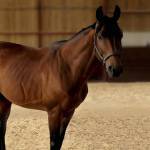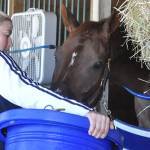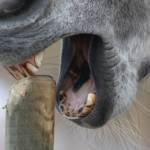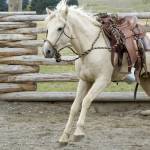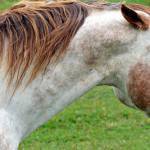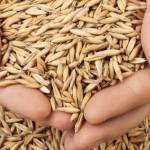Question
Kickup is my seven-year-old Thoroughbred mare. Right now, she’s moderately thin, a 4 on the body condition scorecard. She weighs just over 1,000 lb (450 kg). Her daily diet, split into two meals, includes 18 lb (8.2 kg) of low-carb performance pellet, 1 lb (0.45 kg) high-omega grain, 1 cup ground flaxseed, 1 tablespoon bentonite clay, and 10-15 lb (4.5-6.8 kg) of grass hay. Kickup is an incredibly picky eater, though her appetite improved slightly with bentonite clay. I ride her two or three times a week, depending on the weather. What else can I do to help her gain weight?
Answer
Kickup’s current diet provides an excessive amount of calories, based on her current workload. The amount of digestible energy provided by this diet meets the nutritional needs of the hardest working horses, such as racehorses and advanced three-day-event horses.
If Kickup has not gained weight and condition on this high concentrate intake, identifying the reason why is vital to be able to provide her the appropriate nutrition moving forward. Her reduced appetite and low body condition could be due to digestive discomfort, especially since you have noticed an improvement when feeding bentonite clay. Unfortunately, performance horses are at high risk of developing digestive upset, notably gastric ulcers and hindgut acidosis, both of which require strategic nutritional and management support.
Even horses maintained on regular deworming schedules can fall victim to large parasite burdens that take away from the horse’s nutrition. With increasing reports of parasite resistance to available anthelmintics, or deworming agents, I strongly recommended a deworming program be based on the results of fecal egg counts (FEC) and selection of the appropriate anthelmintic. A veterinarian can help with this.
Without knowing the full reasoning behind your current feeding program, I have put together a ration that provides the appropriate nutrition for a horse that needs additional condition while working at low to moderate intensity.
Maximizing the forage component can add a significant number of calories to the diet. Selecting a high-quality hay, such as an alfalfa-grass mix, allows an increase in the caloric density of the forage quotient without having to significantly increase the amount of hay offered. Offer at least 1.5% body weight as forage for horses that need weight gain and, if possible, free-choice access is best. As well as being higher in energy, the high protein and calcium content of legumes (alfalfa or lucerne, clover, lespedeza) provides additional gastric support through a buffering action, when compared to typical grass hays.
The suggested diet for Kickup includes 18 lb (8.2 kg) of a grass-legume mix hay (approximately 1.5% body weight), and a reduction in the total amount of concentrate feed to 12 lb (5.5 kg) per day using a combination of two feeds: (1) an oat-based, high-fat feed that offers significant calories in the form of highly digestible starch, and (2) a low-starch performance pellet. Feeding a mixture of the two feeds provides multiple energy sources; this is important to note, as many thin horses will gain weight once consumption of various energy substrates (starch, fat, fermentable fiber) begins. I included the feed with higher levels of nonstructural carbohydrate (NSC), as there was no mention of any medical conditions or behavioral considerations that would require a low-NSC feed.
This diet provides the recommended daily allowance set by Kentucky Equine Research for a 1,150-lb (525-kg) horse in moderate work and higher energy needs. Additionally, by increasing the amount of hay offered, this suggested diet has a more favorable forage-to-concentrate ratio (60% forage and 40% concentrate).
Meal size can also impact weight gain. Giving smaller meals more often throughout the day can improve weight gain. Small meals do not overwhelm the digestive tract, particularly the stomach and small intestine, allowing the horse to fully use the nonstructural carbohydrates and fats in the feed. I recommend offering 3-4 lb (1.4-1.8 kg) of feed per meal and no more than 5 lb (2.3 kg) per meal; keep meals at least 5 hours apart. Even though you mention Kickup does not bolt her feed, it is still best to offer small, regular meals of fresh feed.
Horses with dental or respiratory problems sometimes can handle only limited long-stem fiber in their diets, meaning other forage products or complete feeds are frequently offered as hay replacers. However, if Kickup is capable of consuming long-stem hay, then it is best both for digestive health and economic reasons to meet her fiber needs through pasture and hay.
Maintaining optimal digestive health and function is as important as providing enough calories for horses that are habitually hard keepers. To help support digestive health, offer a product like RiteTrac, a buffer that provides support for both the foregut and hindgut. RiteTrac contains EquiShure, the only product available that delivers an active buffer to the hindgut.
EquiShure supplementation helps to maximize fiber digestion and minimize the incidence of colic by ensuring the hindgut microbial population remains stable. Digestive buffers, such as RiteTrac and EquiShure, are recommended for horses that have “gone off feed,” as neutralization of acid in the digestive tract helps to stimulate and improve appetite, while maintaining digestive health and function.
A full complement of gastrointestinal-health products are available to horse owners in Australia.

